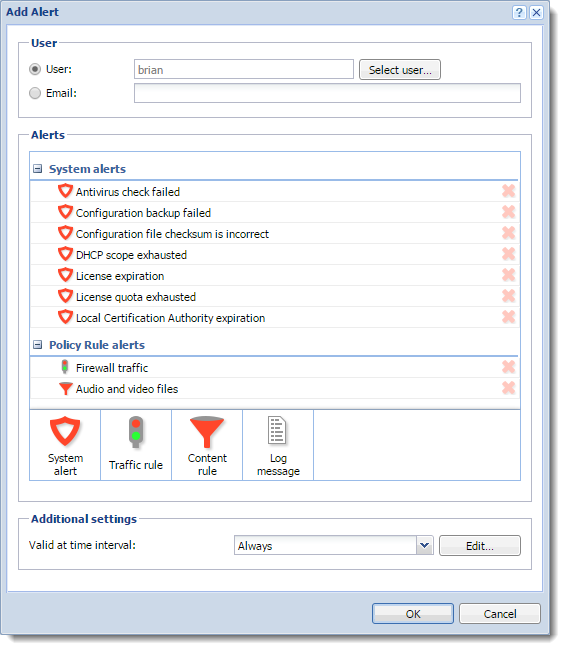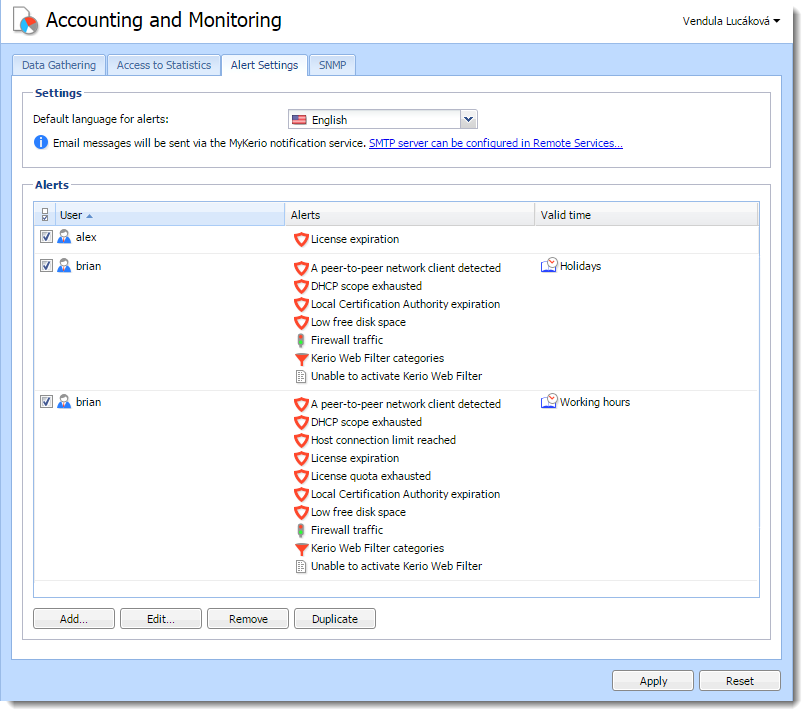Using alert messages
Kerio Control can send automatic email messages (alerts) about important events. You can specify:
- Default alert language
- Recipients
- Alert types
- Timing
NOTE
Ensure your Kerio Control is connected to an SMTP server for sending alerts.
Configuring alerts
- In the administration interface, go to Advanced Options and connect Kerio Control to your SMTP server.
- Go to Accounting and Monitoring > Alert Settings.
- Select a default language for alerts.
- Click Add.
- In the Add Alert dialog box, select a Kerio Control user or type an email address.
- Select the type of alert you want to create:
- System alert — You can choose from many types of system alerts, as described below. For more information refer to System alerts.
- Traffic rule alert — You can create alerts for traffic rules.
- Content rule alert — You can create alerts for content rules.
- Log message alert — You can create custom log message alerts for administrators, as described below. For more information refer to Sending log message alerts.

- Configure the alert and click OK and the Add Alert dialog displays the list of active alerts, grouped by type. You can add more particular alerts for a selected recipient.
- When you have finished adding alerts, select a time interval in which Kerio Control sends the alerts. For more information refer to Creating time ranges in Kerio Control.
- Save your settings.
Kerio Control sends alerts to the selected user. If you need to set up alerts for other users, you can do it in the same way, as shown below.

System alerts
You can add the following system alerts:
- A peer-to-peer network client detected — Kerio Control sends this alert when users start using P2PPeer-to-Peer networks are worldwide distributed systems where each node can be used both as a client and a server.. The alert includes information about IP addressAn identifier assigned to devices connected to a TCP/IP network., resolution (P2P was blocked or traffic was slowed down), and so on.
- Antivirus check failed — Kerio Control sends this alert when the antivirus engine fails to check files (typical for password-protected or damaged files).
- Configuration backup failed — Kerio Control sends this alert when configuration backup to an FTPFile Transfer Protocol - Protocol for transferring computer files from a server. server fails. For details, see Saving configuration to FTP server.
- Configuration file checksum is incorrect — Kerio Control sends this alert when someone changes any configuration file.
- DHCPDynamic Host Configuration Protocol - A protocol that automatically gives IP addresses and additional configuration to hosts in a network. scope exhausted — Kerio Control sends this alert when there are no free IP addresses in the DHCP scope. For more information refer to DHCP server in Kerio Control.
- Host connection limit reached — Kerio Control sends this alert when hosts in the local network reach the connection limit (typical when a Trojan horse or spyware has infected the host).
- Internet connectivity changed — Kerio Control sends this alert when the Internet connection fails and the system switches to a secondary line, or vice versa.
- License expiration — Kerio Control sends this alert 7 days before the expiration of your Kerio Control license, Kerio Control Software Maintenance, Kerio Control Web Filter, or Kerio Antivirus software. The alert is sent daily until you renew the license.
- License quota exhausted — Kerio Control sends two alerts. The first email is sent when 90% of the quota is exhausted. The second email is sent when the quota is fully exhausted.
- Local Certification Authority expiration — Kerio Control sends this alert 7 days before expiration of the local certification authority (CA). You should check the expiration date, create a new local CA, and distribute it to users' browsers. Select this option, if your users use HTTPSHypertext Transfer Protocol - version of HTTP secured by SSL. filtering because they have a local CA installed in their browsers. For more information refer to Filtering HTTPS connections.
- Low free disk space/memory warning — Kerio Control sends this alert when the Kerio Control host has less than 300 MB of free disk space and less than 200 MB of free memory available. Kerio Control needs enough disk space to be able to save logs, statistics, configuration settings, temporary files (e.g. an installation archive of a new version or a file that is currently scanned by an antivirus engine) and other information. Whenever the Kerio Control administrator receives such an alert message, they should immediately take appropriate action.
- New version available — A new version of Kerio Control has been detected on the Kerio Technologies server during an update check.
- RAS line status changed — This alert is sent when a line (PPPoEA type of tunneled link, which is established over top of a physical network interface., PPTPPoint-to-Point Tunneling Protocol - A set of communication rules that allows to extend corporate network through private tunnels over public Internet. or L2TPLayer 2 Tunneling Protocol - A tunneling protocol used with IPsec. interface) is dialed or hung up. The alert message includes a name of the line and type of dialing (manually from the administration interface, automatically in the configured time range, etc.).
- User transfer quota exceeded — A user has reached their daily, weekly or monthly user transfer quota, and Kerio Control has responded by taking the designated action.
NOTE
If you want to send an alert to the user, edit the quota settings of the corresponding user or domain template.
- VPN tunnelKerio Control includes a VPN tunnel which allows to distributed offices to interconnect their offices securely. status changed — This alert works for the Kerio Control VPNVirtual private network - A network that enables users connect securely to a private network over the Internet. tunnel and the IPsecInternet Protocol security - A network protocol used to encrypt and secure data sent over a network. VPN tunnel. Kerio Control sends the alert when status of the tunnel is changed from Up to Down or from Down to Up.
- Virus detected — The antivirus engine has detected a virus in a file transmitted by HTTPHypertext Transfer Protocol - protocol for exchange of hypertext documents in HTML., FTP, SMTP, or POP3Post Office Protocol 3 - A protocol used by local email clients to retrieve emails from mailboxes over a TCP/IP connection..
NOTE
If you want to send an alert to the user, go to Antivirus > HTTP, FTP scanning, and select Alert the client.
Sending log message alerts
For more information refer to Sending log message alerts.
Viewing alerts
To view all generated Kerio Control system alerts, go to Status > Alert Messages. Alerts are displayed in the language chosen for the administration interface.
The left side of the Alerts section lists all alerts sorted by date and time. Each line provides information on one alert:
- Date — Date and time of the event,
- Alert — Event type.
Alert log
All system alert messages are recorded in the Alert log.
The Alert log provides a complete history of system alerts generated by Kerio Control: virus detection, dialing and hanging up, reached quotas, detection of P2P networks, etc.
Each event in the Alert log includes a time stamp (date and time when the event was logged) and information about the alert type (in capitals). The other information varies by alert type.